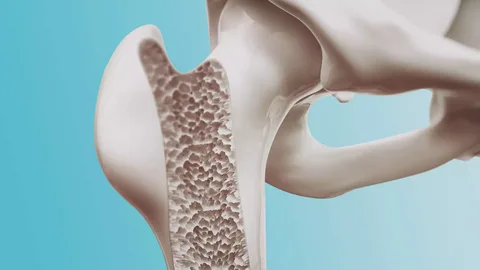Osteoporosis, often referred to as a “silent disease,” affects hundreds of millions of women globally—yet most are unaware until a bone fracture occurs. Characterized by low bone mass and deteriorating bone tissue, osteoporosis in women is far more common than in men, especially after menopause. This medically-reviewed guide explores the causes, symptoms, prevention strategies, and treatments for osteoporosis in women, with a focus on postmenopausal health, diet, and diagnostic tests.
What Is Osteoporosis?
Osteoporosis is a condition where bones become porous, fragile, and prone to fractures, usually without any preceding symptoms. Over time, this leads to a significant loss in bone mineral density (BMD) and overall skeletal strength.
Why Are Women at Higher Risk?
Women are at significantly greater risk than men due to biological, hormonal, and lifestyle factors. According to the International Osteoporosis Foundation, up to 1 in 3 women over 50 will suffer an osteoporosis-related fracture.
Key Reasons Women Are More Affected:
-
Smaller and thinner bones compared to men
-
Estrogen drop during menopause, accelerating bone loss
-
Longer life expectancy means more years at risk
-
Pregnancy & breastfeeding deplete calcium stores
Osteoporosis and Menopause
Estrogen plays a crucial role in maintaining bone density. During menopause, estrogen levels drop sharply, triggering rapid bone loss. Women can lose up to 20% of their bone mass within 5–7 years post-menopause. Important: Bone loss can begin as early as perimenopause, making early screening essential.
Symptoms of Osteoporosis in Women
Early osteoporosis has no symptoms, and most women don’t realize they have it until a fracture occurs.
When symptoms appear:
-
Back pain from vertebral fractures
-
Loss of height
-
Stooped posture (kyphosis or “dowager’s hump”)
-
Fractures from simple actions (bending, coughing, tripping)
-
Bone pain or tenderness
Causes of Osteoporosis in Women
Primary Causes & Their Impact on Bone Health:
| Cause | How It Affects Bone Health |
|---|---|
| Hormonal changes | Menopause & estrogen deficiency |
| Ageing | Natural bone loss accelerates with age |
| Nutritional deficiency | Low calcium & vitamin D weaken bones |
| Sedentary lifestyle | Lack of weight-bearing exercise lowers BMD |
| Smoking & alcohol | Interfere with calcium absorption |
| Genetics | Family history increases risk |
| Chronic diseases | Thyroid issues, celiac disease, rheumatoid arthritis |
| Medications | Long-term steroid & anticonvulsant use |
Osteoporosis Risk Factors in Women
You may be at risk if you:
-
Are over 50 or postmenopausal
-
Have a family history of osteoporosis
-
Have had a previous fracture
-
Are underweight or have an eating disorder
-
Have vitamin D deficiency
-
Smoke or drink excessively
-
Take corticosteroids regularly
-
Live a sedentary lifestyle
Bone Density Test for Women
The most reliable diagnostic tool is Dual-Energy X-ray Absorptiometry (DEXA/DXA scan), measuring bone mineral density in the hip and spine.
Recommended Screening:
-
All women over 65
-
Postmenopausal women under 65 with risk factors
-
Women with a history of fractures
How to Prevent Osteoporosis in Women
Top prevention strategies:
-
Calcium: 1,200 mg/day for women over 50
-
Vitamin D: Sunlight or supplements
-
Weight-bearing exercises: Walking, dancing, resistance training
-
Quit smoking & limit alcohol
-
Avoid crash diets & nutrient deficiencies
-
Prevent falls at home (install railings, remove clutter)
Osteoporosis Diet for Women
Foods That Support Bone Health:
| Nutrient | Best Sources |
|---|---|
| Calcium | Dairy, leafy greens, almonds, sesame |
| Vitamin D | Sunlight, fortified milk, fatty fish |
| Magnesium | Pumpkin seeds, avocados, spinach |
| Protein | Eggs, tofu, lentils, lean meats |
| Vitamin K2 | Natto, eggs, hard cheeses |
| Zinc | Chickpeas, nuts, whole grains |
| Avoid excessive caffeine, soda, and salty processed foods. |
Best Supplements for Osteoporosis in Women
When diet & sunlight aren’t enough:
-
Calcium carbonate or citrate
-
Vitamin D3 (cholecalciferol)
-
Magnesium with vitamin B6
-
Vitamin K2 (MK-7 form)
-
Collagen or strontium (advanced cases)
Always consult a doctor before starting supplements.
Osteoporosis Treatment: Medical Options for Women
| Drug Class | Examples | Effect |
|---|---|---|
| Bisphosphonates | Alendronate, Risedronate | Slow bone loss |
| SERMs | Raloxifene | Mimic estrogen to protect bones |
| Parathyroid Hormone | Teriparatide (Forteo) | Stimulates bone formation |
| Monoclonal Antibodies | Denosumab | Prevents bone breakdown |
| Hormone Therapy | Estrogen (select cases) | Used for younger postmenopausal women |
Living with Osteoporosis: Tips for Safer, Stronger Living
-
Exercise safely to maintain balance & strength
-
Modify your home to reduce fall risks
-
Get regular check-ups & BMD scans
-
Stay consistent with medication & nutrition
-
Join support groups or education programs
Conclusion
Osteoporosis in women is often silent until it’s too late. But awareness, early testing, and proactive steps can preserve bone health well into old age. Whether you’re 30, 50, or 70, it’s never too early—or too late—to build stronger bones.
FAQs About Osteoporosis in Women
At what age should women worry about osteoporosis? Women should begin preventive steps in their 30s; regular screening is recommended after 50.
Is osteoporosis reversible? Bone mass can’t be fully restored, but progression can be slowed, reducing fracture risk.
Can young women get osteoporosis? Yes, especially those with eating disorders, hormonal issues, or long-term steroid use.
How is osteoporosis diagnosed? Through a DEXA scan measuring bone mineral density.
What is the best exercise for osteoporosis? Weight-bearing activities like brisk walking, resistance training, and balance exercises (tai chi, yoga).
Read More: Signs and Symptoms of Vitamin D Deficiency


